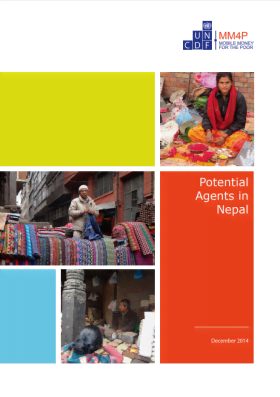Potential Agents in Nepal
Nepal is characterised by unique geographical diversity, with regions consisting of mountains (parbat), hills (pahar) and lowands (terai). Numerous financial institutions in a variety of forms—such as banks, savings and credit co-operatives (SACCOs) and microfinance institutions—are engaged in expanding access to finance for the Nepalese people. Despite these efforts, a significant proportion of the population lacks access to finance. This gap is mainly due to low population density in several regions, challenging terrain and topography and poor infrastructure (roads, connectivity, telecommunication and internet service), all of which make greater access to finance difficult to achieve.
In the past, the Government and private sector institutions conducted several studies to assess the need for financial services among low-income households in Nepal. In the wake of these studies, the Government and Nepal Rastra Bank have been proactively focused on paving the way for the financial sector to provide universal access. Nepal Rastra Bank introduced regulations to provide banking services through bank-led agency models, anchored on digital/branchless financial services.
The potential customers and the financial sector have been at the centre of the focus on financial inclusion, with significant research, discussion and debate on the issues faced by customers. However, due emphasis has not been placed on the agents, who are and would be the most important cogs in the emerging financial services machinery. Currently, the number of agents serving the unbanked population pales in comparison to similar figures in mature mobile money markets such as Kenya or Bangladesh. Until now, there has been no design to agent selection. Rather, it has basically occurred by default, based on an expansion strategy in which anyone interested was selected as an agent. There is no set of selection criteria or research on the profile of potential agents, the segments in which they operate and their motivations/aspirations/expectations for becoming banking agents. This gap has resulted in a mismatch of agents’ expectations and the value propositions offered by banks, which could lead to the dissatisfaction of agents in the medium and long term. In the interests of branchless-banking stakeholders, UNCDF through its MM4P programme commissioned this research to identify potential agents, the segments in which they operate and their motivations to become mobile banking agents.
The research was undertaken with two key objectives:
- to identify which businesses are suitable
to be branchless banking agencies and - to suggest an appropriate value proposition for each
suitable business identified.
The research covered 21 districts in five development regions of Nepal. During the research, the team covered 346 customers and 114 businesses, using four different qualitative research tools: focus-group discussions, personal interviews, product attribute ranking and relative preference ranking.



